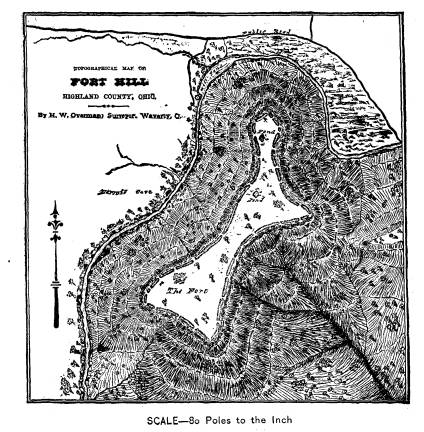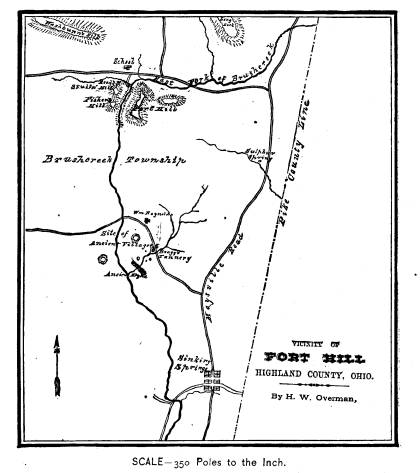Ohio History Journal
FORT HILL, OHIO.
FORT HILL
is situated in the southeastern corner of High-
land county, Ohio, one and a half miles
west of Pike county
line, and three miles north of the
village of Sinking Springs.
The base of the hill is bounded on the
north and west by the
East Fork of Ohio Brush Creek. Its
elevation is about five
hundred feet above the bed of the stream
and thirteen hundred
feet above the level of the sea. The
base of the hill rests upon
one hundred and fifty feet of Niagara
limestone, followed by
two hundred and fifty feet of Huron
shale and capped with
about one hundred feet of Waverly shales
and sandstone.
The leading point of interest, and the
source from which
the hill derives its name, is the
ancient artificial wall of earth-
work which completely encloses the level
plateau on its sum-
mit. This was evidently constructed by
an excavation of
earth and stones around the brink of the
hill thus raising a
wall, which, at the present time, has a
base averaging twenty-
five feet and a height averaging from
six to ten feet.
Its entire length is 8,582 feet. It
contains 50,856 cubic
yards of material. At the present day, with our modern
methods of construction, it would cost not
less than twenty
thousand dollars.
The area enclosed is thirty-five acres.
The gateways or
entrances are thirty-three in number and
are spaces from ten
to fifteen feet in width, arranged
without apparent order or
regularity except that an average number
is found on either
side, - the eastern half containing the
same number as the
western. The same may be said as to the
northern and
southern divisions.
The space enclosed is level and is
almost entirely covered
with forest, which extends in all
directions to the base of the
hill. There are two small ponds, known
locally as "Bear
Wallows," one located near the
northern extremity, the other
in the north-central part of the Fort.
In winter and during
rainy weather these ponds contain water,
and could be made
260
|
Fort Hill, Ohio. 261 to hold and retain almost any desired quantity. The entire circumference of the wall for at least one hundred feet from the summit is very steep and precipitous, so that the inmates would certainly be able to repel a much superior force from the outside; |
|
|
|
The query naturally arises as to where the inhabitants had their permanent residence. A partial answer at least may be made to this question from an examination of the evidences of the former existence of a considerable village or settle- ment about one mile south of the summit of the hill. At |
|
262 Ohio Archaeological and Historical Quarterly. this point the ground is somewhat undulating and intersected by numerous ravines, from which issue springs of the purest and coldest water. Here may be seen, a short distance south- west of the residence of William Reynolds, Esq., in a culti- |
|
|
|
vated field, about thirty rods east of the creek, a circular earthwork of about three hundred feet in diameter. This field has been under cultivation a number of years, yet the outlines of the work are still plainly visible. |
Fort Hill, Ohio. 263
Another work of like size and character
is situated on the
west side of the creek, and at an equal
distance from it.
About a half-mile south of the
first-named circular work is
another work similar in character but
much smaller, being
but fifty feet in diameter. There are
also in this latter vicinity
many other evidences of various kinds,
such as mounds, etc.
Numerous implements of stone and of
flint have been discov-
ered from time to time, and deposits of
mica, as well as spec-
imens of galena, whether native or not,
are frequently met
with.
A short distance below Bragg's Tannery,
on a small stream
which is fed by a number of fine
springs, there seems to
have been a dyke thrown across the
stream, which would
form a lake of considerable extent in
the basin-shaped valley.
We may reasonably conjecture that the
great Fort on the
hill was constructed as a place of
refuge and protection in
case of invasion.
The vicinity of Fort Hill is by no
means void of natural
scenery. The channel of Brush creek has
cut its way through
an immense gorge of Niagara limestone
for a distance of two
or three miles, forming numerous cliffs
and caverns. On the
west side of this gorge, at the foot of
Fisher's hill, is a cave,
once occupied by David Davis, an
ingenious and eccentric
hermit, who made the cavern his home
for a number of years
from about 1847. He discovered a vein
of ore near his
abode from which he manufactured in limited
quantities a
valuable and durable metallic paint, of
a color approaching a
rose tint, and of metallic luster,
which gained considerable
local reputation. The ore, however, so
far as yet discovered,
is not in paying quantities. His cave
and surrounding scen-
ery, situated as it is in one of the
most romantic regions of
Southern Ohio, is well worthy of
inspection.
This gorge, in the opinion of the
writer, is of post-glacial
origin, an idea probably announced for
the first time. The
entire drainage of the country north of
Fort Hill once had
its outlet into Paint creek, ten or
twelve miles northeast of
here at a point a short distance above
Bainbridge, in Ross
county. This outlet has been completely
blocked up and
264 Ohio Archaeological and
Historical Quarterly.
filled to a sufficient height to force
the water in the direction
it now assumes. The filling of this old
valley at its outlet
into Paint creek was caused by the vast
accumulation of gla-
cial deposits brought in by the ice.
As this is a question for the geologist,
there is no need of
further discussion in this article.
H. W. OVERMAN.

